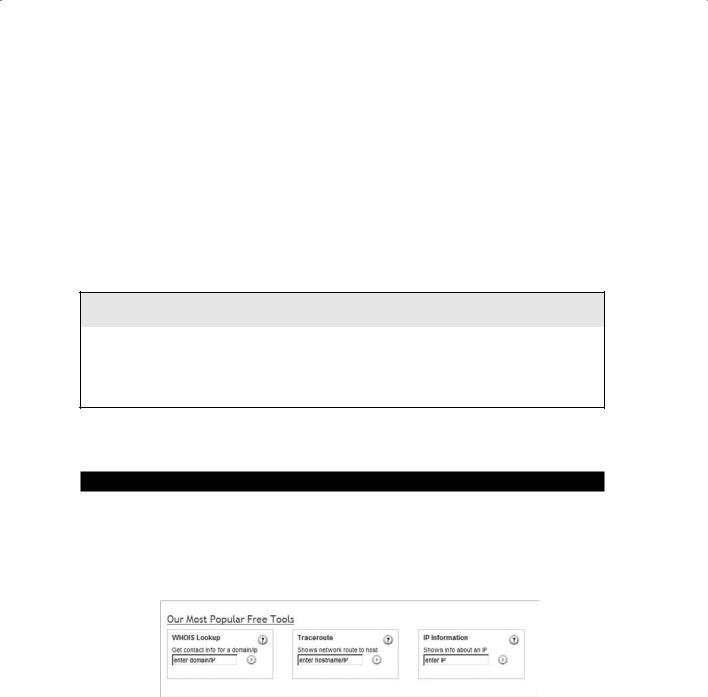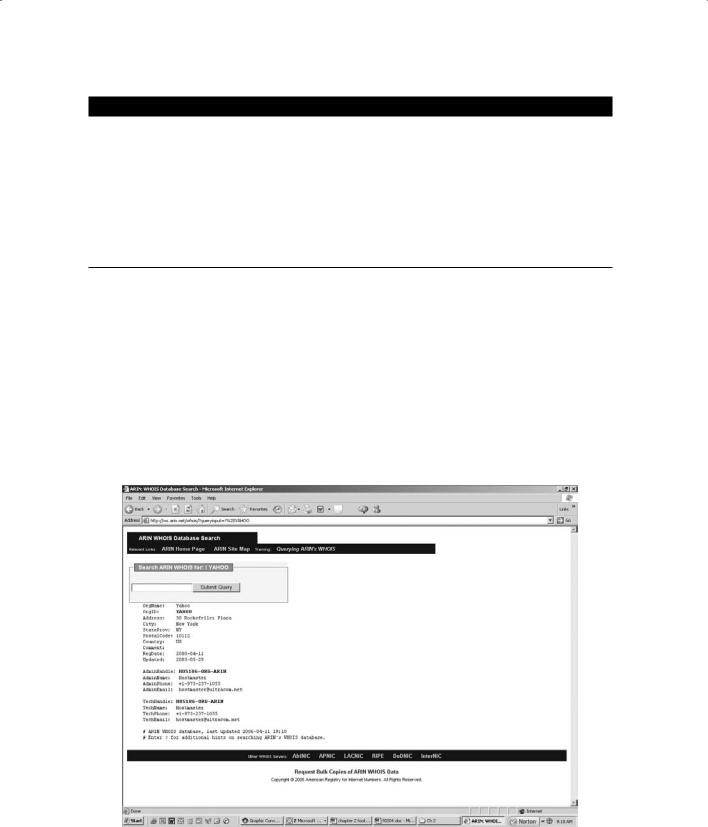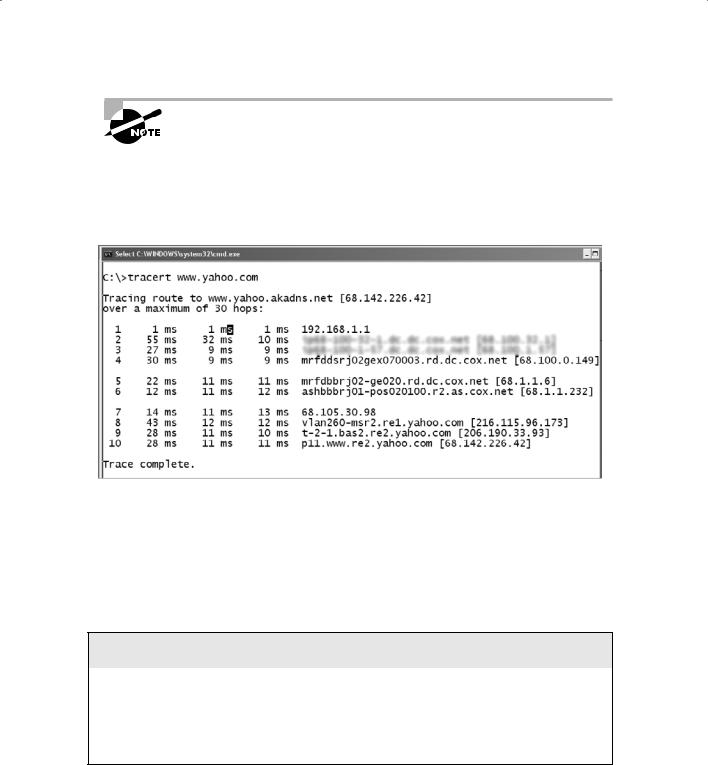
- •Acknowledgments
- •About the Author
- •Contents at a Glance
- •Contents
- •Table of Exercises
- •Introduction
- •Assessment Test
- •Answers to Assessment Test
- •Defining Ethical Hacking
- •How to Be Ethical
- •Keeping It Legal
- •Summary
- •Exam Essentials
- •Review Questions
- •Answers to Review Questions
- •Reconnaissance
- •Information-Gathering Methodology
- •Social Engineering
- •Summary
- •Exam Essentials
- •Review Questions
- •Answers to Review Questions
- •Scanning
- •Enumeration
- •Summary
- •Exam Essentials
- •Review Questions
- •Answers to Review Questions
- •The Simplest Way to Get a Password
- •Types of Passwords
- •Cracking a Password
- •Understanding Keyloggers and Other Spyware Technologies
- •Escalating Privileges
- •Understanding Rootkits
- •Hiding Files
- •Understanding Steganography Technologies
- •Summary
- •Exam Essentials
- •Review Questions
- •Answers to Review Questions
- •Trojans and Backdoors
- •Viruses and Worms
- •Summary
- •Exam Essentials
- •Review Questions
- •Answers to Review Questions
- •How a Sniffer Works
- •Sniffing Countermeasures
- •Bypassing the Limitations of Switches
- •Wireshark Filters
- •Summary
- •Exam Essentials
- •Review Questions
- •Answers to Review Questions
- •Denial of Service
- •Session Hijacking
- •Summary
- •Exam Essentials
- •Review Questions
- •Answers to Review Questions
- •How Web Servers Work
- •Types of Web Server Vulnerabilities
- •Web Application Vulnerabilities
- •Summary
- •Exam Essentials
- •Review Questions
- •Answers to Review Questions
- •SQL Injection
- •Buffer Overflows
- •Summary
- •Exam Essentials
- •Review Questions
- •Answers to Review Questions
- •Wi-Fi and Ethernet
- •Authentication and Cracking Techniques
- •Using Wireless Sniffers to Locate SSIDs
- •MAC Filters and MAC Spoofing
- •Rogue Access Points
- •Wireless Hacking Techniques
- •Securing Wireless Networks
- •Summary
- •Exam Essentials
- •Review Questions
- •Answers to Review Questions
- •Components of Physical Security
- •Understanding Physical Security
- •Physical Site Security Countermeasures
- •What to Do After a Security Breach Occurs
- •Summary
- •Exam Essentials
- •Review Questions
- •Answers to Review Questions
- •Linux Basics
- •Compiling a Linux Kernel
- •GCC Compilation Commands
- •Installing Linux Kernel Modules
- •Linux Hardening Methods
- •Summary
- •Exam Essentials
- •Review Questions
- •Answers to Review Questions
- •Types of IDSs and Evasion Techniques
- •Summary
- •Exam Essentials
- •Review Questions
- •Answers to Review Questions
- •Generating Public and Private Keys
- •Cryptography Algorithms
- •Summary
- •Exam Essentials
- •Review Questions
- •Answers to Review Questions
- •Defining Security Assessments
- •Penetration Testing
- •Pen Test Deliverables
- •Summary
- •Exam Essentials
- •Review Questions
- •Answers to Review Questions
- •Glossary
- •Index

Information-Gathering Methodology |
37 |
E x e r c i s e 2 . 3 ( c o n t i n u e d )
6.Use Google Groups and job-posting websites to search on the names you have found. Are there any IT jobs posted or other information in the newsgroups that would indicate the type of network or systems the organization has?
The website www.Netcraft.com is another good source for passive information gathering. The website will attempt to determine the operating system and web server version running on a web server. This tool will be further discussed in the following chapter.
Information-Gathering Methodology
Information gathering can be broken into seven logical steps (see Figure 2.1). Footprinting is performed during the first two steps of unearthing initial information and locating the network range.
F i gu r e 2 .1 Seven steps of information gathering
|
Footprinting |
|
|
Unearth Initial Information |
|
|
|
|
|
||
|
|
|
|
||
|
|
|
|
|
|
|
|
|
|
|
|
|
|
|
|
Locate the Network Range |
|
|
|
|
|
|
|
|
|
|
|
|
|
|
|
|
|
|
|
|
|
|
|
Ascertain Active Machines |
|
|
|
|
|
|
|
|
|
|
|
|
|
|
|
|
|
Discover Open Ports/Access Points |
|
|
|
|
|
|
|
|
|
|
|
|
|
|
|
|
|
Detect Operating Systems |
|
|
|
|
|
|
|
|
|
|
|
|
|
|
|
|
|
Uncover Services on Ports |
|
|
|
|
|
|
|
|
|
|
|
|
|
|
|
|
|
Map the Network |
|
|
|
|
|
|
|
|
|
|
|
|
|
The other information-gathering steps are covered in Chapter 3, “Gathering Network and Host Information: Scanning and Enumeration.”

38 Chapter 2 n Gathering Target Information
Footprinting
Footprinting is defined as the process of creating a blueprint or map of an organization’s network and systems. Information gathering is also known as footprinting an organization. Footprinting begins by determining the target system, application, or physical location of the target. Once this information is known, specific information about the organization
is gathered using nonintrusive methods. For example, the organization’s own web page may provide a personnel directory or a list of employee bios, which may prove useful if the hacker needs to use a social-engineering attack to reach the objective.
The information the hacker is looking for during the footprinting phase is anything that gives clues as to the network architecture, server, and application types where valuable data is stored. Before an attack or exploit can be launched, the operating system and version as well as application types must be uncovered so the most effective attack can be launched against the target. Here are some of the pieces of information to be gathered about a target during footprinting:
NN |
Domain name |
|
|
NN |
Network blocks |
|
|
NN |
Network services and applications |
NN |
System architecture |
NN |
Intrusion detection system |
NN |
Authentication mechanisms |
NN |
Specific IP addresses |
NN |
Access control mechanisms |
NN |
Phone numbers |
|
|
NN |
Contact addresses |
|
Once this information is compiled, it can give a hacker better insight into the organization, where valuable information is stored, and how it can be accessed.
Footprinting Tools
Footprinting can be done using hacking tools, either applications or websites, which allow the hacker to locate information passively. By using these footprinting tools, a hacker can gain some basic information on, or “footprint,” the target. By first footprinting the target, a hacker can eliminate tools that will not work against the target systems or network. For example, if a graphics design firm uses all Macintosh computers, then all hacking software that targets Windows systems can be eliminated. Footprinting not only speeds up the hacking process by eliminating certain toolsets but also minimizes the chance of detection as fewer hacking attempts can be made by using the right tool for the job.
For the exercises in this chapter, you will perform reconnaissance and information gathering on a target company. I recommend you use your own organization, but because these tools are passive, any organization name can be used.

Information-Gathering Methodology |
39 |
Some of the common tools used for footprinting and information gathering are as follows:
NN |
Domain name lookup |
|
|
NN |
Whois |
|
|
NN |
NSlookup |
|
|
NN |
Sam Spade |
|
Before we discuss these tools, keep in mind that open source information can also yield a wealth of information about a target, such as phone numbers and addresses. Performing Whois requests, searching domain name system (DNS) tables, and using other lookup web tools are forms of open source footprinting. Most of this information is fairly easy to get and legal to obtain.
Footprinting a Target
Footprinting is part of the preparatory preattack phase and involves accumulating data regarding a target’s environment and architecture, usually for the purpose of finding ways to intrude into that environment. Footprinting can reveal system vulnerabilities and identify the ease with which they can be exploited. This is the easiest way for hackers to gather information about computer systems and the companies they belong to. The purpose of this preparatory phase is to learn as much as you can about a system, its remote access capabilities, its ports and services, and any specific aspects of its security.
Using Google to Gather Information
A hacker may also do a Google search or a Yahoo! People search to locate information about employees or the organization itself.
The Google search engine can be used in creative ways to perform information gathering. The use of the Google search engine to retrieve information has been termed Google hacking. Go to http://groups.google.com to search the Google newsgroups. The following commands can be used to have the Google search engine gather target information:
site Searches a specific website or domain. Supply the website you want to search after the colon.
filetype Searches only within the text of a particular type of file. Supply the file type you want to search after the colon. Don’t include a period before the file extension.
link Searches within hyperlinks for a search term and identifies linked pages. cache Identifies the version of a web page. Supply the URL of the site after the colon. intitle Searches for a term within the title of a document.
inurl Searches only within the URL (web address) of a document. The search term must follow the colon.

40 Chapter 2 n Gathering Target Information
For example, a hacker could use the following command to locate certain types of vulnerable web applications:
INURL:[“parameter=”] with FILETYPE:[ext] and INURL:[scriptname]
Or a hacker could use the search string intitle: “BorderManager information alert” to look for Novell BorderManager proxy/firewall servers.
For more syntax on performing Google searches, visit www.google.com/ help/refinesearch.html.
Blogs, newsgroups, and press releases are also good places to find information about the company or employees. Corporate job postings can provide information as to the type of servers or infrastructure devices a company may be using on its network.
Other information obtained may include identification of the Internet technologies being used, the operating system and hardware being used, active IP addresses, email addresses and phone numbers, and corporate policies and procedures.
Generally, a hacker spends 90 percent of the time profiling and gathering information on a target and 10 percent of the time launching the attack.
Understanding DNS Enumeration
DNS enumeration is the process of locating all the DNS servers and their corresponding records for an organization. A company may have both internal and external DNS servers that can yield information such as usernames, computer names, and IP addresses of potential target systems.
NSlookup, DNSstuff, the American Registry for Internet Numbers (ARIN), and Whois can all be used to gain information that can then be used to perform DNS enumeration.
NSlookup and DNSstuff
One powerful tool you should be familiar with is NSlookup (see Figure 2.2). This tool queries DNS servers for record information. It’s included in Unix, Linux, and Windows operating systems. Hacking tools such as Sam Spade also include NSlookup tools.
Building on the information gathered from Whois, you can use NSlookup to find additional IP addresses for servers and other hosts. Using the authoritative name server information from Whois (AUTH1.NS.NYI.NET), you can discover the IP address of the mail server.

Information-Gathering Methodology |
41 |
F i gu r e 2 . 2 NSlookup
The explosion of easy-to-use tools has made hacking easy, if you know which tools to use. DNSstuff is another of those tools. Instead of using the command-line NSlookup tool with its cumbersome switches to gather DNS record information, just access the website www.dnsstuff.com, and you can do a DNS record search online. Figure 2.3 shows a sample DNS record search on www.eccouncil.org using DNSstuff.com.
F i gu r e 2 . 3 DNS record search of www.eccouncil.org
This search reveals all the alias records for www.eccouncil.org and the IP address of the web server. You can even discover all the name servers and associated IP addresses.
The exploits available to you because you have this information are discussed in Chapter 4, “System Hacking: Password Cracking, Escalating Privileges, and Hiding Files.”

42 Chapter 2 n Gathering Target Information
Understanding Whois and ARIN Lookups
Whois evolved from the Unix operating system, but it can now be found in many operating systems as well as in hacking toolkits and on the Internet. This tool identifies who has registered domain names used for email or websites. A uniform resource locator (URL), such as www.Microsoft.com, contains the domain name (Microsoft.com) and a hostname or alias (www).
The Internet Corporation for Assigned Names and Numbers (ICANN) requires registration of domain names to ensure that only a single company uses a specific domain name. The Whois tool queries the registration database to retrieve contact information about the individual or organization that holds a domain registration.
Hacking Tool
SmartWhois is an information-gathering program that allows you to find all available information about an IP address, hostname, or domain, including country, state or province, city, name of the network provider, administrator, and technical support contact information. SmartWhois is a graphical version of the basic Whois program.
In Exercise 2.4, I will show you how to use a free Whois tool.
E x e r c i s e 2 . 4
Using Whois
To use the Whois tool to gather information on the registrar or a domain name:
1.Go to the DNSStuff.com website and scroll down to the free tools at the bottom of the page.
2.Enter your target company URL in the WHOIS Lookup field and click the WHOIS button.
3.Examine the results and determine the following:
Registered address
Technical and DNS contacts
Contact email

Information-Gathering Methodology |
43 |
E x e r c i s e 2 . 4 ( c o n t i n u e d )
Contact phone number
Expiration date
4.Visit the company website and see if the contact information from WHOIS matches up to any contact names, addresses, and email addresses listed on the website.
5.If so, use Google to search on the employee names or email addresses. You can learn the email naming convention used by the organization, and whether there is any information that should not be publicly available.
ARIN is a database that includes such information as the owners of static IP addresses. The ARIN database can be queried using the Whois tool, such as the one located at www.arin.net.
Figure 2.4 shows an ARIN Whois search for www.yahoo.com. Notice that addresses, emails, and contact information are all contained in this Whois search. This information can be used by an ethical hacker to find out who is responsible for a certain IP address and which organization owns that target system, or it can be used by a malicious hacker to perform a social-engineering attack against the organization. As a security professional, you need to be aware of the information available to the public in searchable databases such as ARIN and ensure that a malicious hacker can’t use this information to launch an attack against the network.
F i gu r e 2 . 4 ARIN output for www.Yahoo.com

44 Chapter 2 n Gathering Target Information
Be aware that other geographical regions outside North American have their own Internet registries, such as RIPE NCC (Europe, the Middle East, and parts of Central Asia), LACNIC (Latin American and Caribbean Internet Addresses Registry), and APNIC (Asia Pacific Network Information Centre).
Analyzing Whois Output
A simple way to run Whois is to connect to a website (for instance, www.networksolutions
.com) and conduct the Whois search. Listing 2.1 is the output of a Whois search of the site www.eccouncil.org.
The contact names and server names in this book have been changed.
Listing 2.1
W h o i s ou t pu t fo r w w w . eccou n c i l .o r g
Domain ID:D81180127-LROR
Domain Name:ECCOUNCIL.ORG
Created On:14-Dec-2001 10:13:06 UTC
Last Updated On:19-Aug-2004 03:49:53 UTC
Expiration Date:14-Dec-2006 10:13:06 UTC
Sponsoring Registrar:Tucows Inc. (R11-LROR)
Status:OK
Registrant ID:tuTv2ItRZBMNd4lA
Registrant Name: John Smith
Registrant Organization:International Council of E-Commerce Consultants
Registrant Street1:67 Wall Street, 22nd Floor
Registrant Street2:
Registrant Street3:
Registrant City:New York
Registrant State/Province:NY
Registrant Postal Code:10005-3198
Registrant Country:US
Registrant Phone:+1.2127098253
Registrant Phone Ext.:
Registrant FAX:+1.2129432300

Information-Gathering Methodology |
45 |
Registrant FAX Ext.:
Registrant Email:forum@eccouncil.org Admin ID:tus9DYvpp5mrbLNd
Admin Name: Susan Johnson
Admin Organization:International Council of E-Commerce Consultants Admin Street1:67 Wall Street, 22nd Floor
Admin Street2:
Admin Street3: Admin City:New York
Admin State/Province:NY Admin Postal Code:10005-3198 Admin Country:US
Admin Phone:+1.2127098253 Admin Phone Ext.:
Admin FAX:+1.2129432300 Admin FAX Ext.:
Admin Email:ethan@eccouncil.org Tech ID:tuE1cgAfi1VnFkpu
Tech Name:Jacob Eckel
Tech Organization:International Council of E-Commerce Consultants Tech Street1:67 Wall Street, 22nd Floor
Tech Street2:
Tech Street3: Tech City:New York
Tech State/Province:NY Tech Postal Code:10005-3198 Tech Country:US
Tech Phone:+1.2127098253 Tech Phone Ext.:
Tech FAX:+1.2129432300 Tech FAX Ext.:
Tech Email:forum@eccouncil.org
Name Server: ns1.xyz.net Name Server: ns2.xyz.net
Notice the four highlighted lines. The first shows the target company or person (as well as their physical address, email address, phone number, and so on). The next shows the administration or technical contact (and their contact information). The last two highlighted lines show the names of domain name servers.

46 Chapter 2 n Gathering Target Information
Finding the Address Range of the Network
Every ethical hacker needs to understand how to find the network range and subnet mask of the target system. IP addresses are used to locate, scan, and connect to target systems. You can find IP addresses in Internet registries such as ARIN or the Internet Assigned Numbers Authority (IANA).
An ethical hacker may also need to find the geographic location of the target system or network. This task can be accomplished by tracing the route a message takes as it’s sent to the destination IP address. You can use tools like traceroute, VisualRoute, and NeoTrace to identify the route to the target.
Additionally, as you trace your target network, other useful information becomes available. For example, you can obtain internal IP addresses of host machines; even the Internet IP gateway of the organization may be listed. These addresses can then be used later in an attack or further scanning processes.
Identifying Types of DNS Records
The following list describes the common DNS record types and their use: A (Address) Maps a hostname to an IP address
SOA (Start of Authority) Identifies the DNS server responsible for the domain information CNAME (Canonical Name) Provides additional names or aliases for the address record MX (Mail Exchange) Identifies the mail server for the domain
SRV (Service) Identifies services such as directory services PTR (Pointer) Maps IP addresses to hostnames
NS (Name Server) Identifies other name servers for the domain
Using Traceroute in Footprinting
Traceroute is a packet-tracking tool that is available for most operating systems. It operates by sending an Internet Control Message Protocol (ICMP) echo to each hop (router or gateway) along the path, until the destination address is reached. When ICMP messages are sent back from the router, the time to live (TTL) is decremented by one for each router along the path. This allows a hacker to determine how many hops a router is from the sender.
One problem with using the traceroute tool is that it times out (indicated by an asterisk) when it encounters a firewall or a packet-filtering router. Although a firewall stops the trace route tool from discovering internal hosts on the network, it can alert an ethical hacker to the presence of a firewall; then, techniques for bypassing the firewall can be used.

Information-Gathering Methodology |
47 |
These techniques are part of system hacking, which is discussed in
Chapter 4.
and many other hacking tools include a version of traceroute. The Windows operating systems use the syntax tracert hostname to perform a traceroute. Figure 2.5 is an example of traceroute output for a trace of www.yahoo.com.
F i gu r e 2 . 5 Traceroute output for www.yahoo.com
Notice in Figure 2.5 that the message first encounters the outbound ISP to reach the Yahoo! web server, and that the server’s IP address is revealed as 68.142.226.42. Knowing this IP address enables the ethical hacker to perform additional scanning on that host during the scanning phase of the attack.
The tracert command identifies routers located en route to the destination’s network. Because routers are generally named according to their physical location, tracert results help you locate these devices.
Hacking Tools
NeoTrace, VisualRoute, and VisualLookout are all packet-tracking tools with a GUI or visual interface. They plot the path the packets travel on a map and can visually identify the locations of routers and other internetworking devices. These tools operate similarly to traceroute and perform the same information gathering; however, they provide a visual representation of the results.
